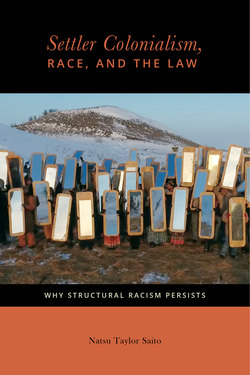Читать книгу Settler Colonialism, Race, and the Law - Natsu Taylor Saito - Страница 40
На сайте Литреса книга снята с продажи.
Forced Removals
ОглавлениеBy 1801 Thomas Jefferson was already predicting that “our rapid multiplication will expand itself . . . [to] cover the whole northern, if not the southern continent, with a people speaking the same language, governed in similar forms, and by similar laws,” a vision not to be sullied by “blot or mixture.”78 Between 1790 and 1840 some 4.5 million Euroamerican settlers appropriated lands west of the Appalachians, and by 1850 the United States claimed the Pacific Ocean as its western border. Just forty years later, “North America’s Native peoples would be living mainly on reservations controlled by the US government or in its rapidly growing cities,” their “pre-contact” population and land base reduced by more than 95 percent.79
The terms “removal” and “relocation” are deceptively benign, masking the horrors attending this genocidal process. Between 1813 and 1855 most of the eastern peoples who had not already been coerced into moving west were forcibly removed. The best-known example, of course, is that of the Cherokee Trail of Tears. Snatched from their homes at gunpoint, often by settler vigilantes who then burned their houses, the Cherokees were concentrated in military stockades before being force-marched some 1,200 miles from their Georgia/North Carolina homeland to Oklahoma. The Choctaws, Chickasaws, Creeks, and Seminoles, as well as numerous smaller nations, were similarly “removed.” Suffering from exhaustion, exposure, starvation, and disease, many nations lost 50 percent or more of their populations as a result.80
Why were these nations so brutally expelled from their traditional lands? Incompatibility of Indigenous and settler lifestyles is often presumed, but at the time of their displacement the Cherokees had signed numerous treaties with the United States protecting their right to remain on their lands, and there were no hostilities occurring.81 They were settled agriculturalists with a sound economic base and political, legal, and social institutions easily recognized as such by the colonizers.82 The real problem may well have been “the Cherokee’s unmistakable aptitude for civilization,”83 for this undermined the settlers’ justifications for seizing coveted lands. As Wolfe observed, the Cherokees’ adoption of settler practices was particularly provocative because it “signified permanence.”84
